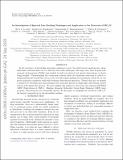An investigation of spectral line stacking techniques and application to the detection of HC11N
Author(s)
Loomis, Ryan A; Burkhardt, Andrew M; Shingledecker, Christopher N; Charnley, Steven B; Cordiner, Martin A; Herbst, Eric; Kalenskii, Sergei; Lee, Kin Long Kelvin; Willis, Eric R; Xue, Ci; Remijan, Anthony J; McCarthy, Michael C; McGuire, Brett A; ... Show more Show less
DownloadSubmitted version (31.00Mb)
Publisher Policy
Publisher Policy
Article is made available in accordance with the publisher's policy and may be subject to US copyright law. Please refer to the publisher's site for terms of use.
Terms of use
Metadata
Show full item recordAbstract
© 2021, The Author(s), under exclusive licence to Springer Nature Limited. As the inventory of interstellar molecules continues to grow, the gulf between small species, whose individual rotational lines can be observed with radio telescopes, and large ones, such as polycyclic aromatic hydrocarbons best studied in bulk via infrared and optical observations, is slowly being bridged. Understanding the connection between these two molecular reservoirs is critical to understanding the interstellar carbon cycle, but will require pushing the boundaries of how far we can probe molecular complexity while still retaining observational specificity. Towards this end, we present a method for detecting and characterizing new molecular species in single-dish observations towards sources with sparse line spectra. We have applied this method to data from the ongoing GOTHAM (GBT Observations of TMC-1: Hunting Aromatic Molecules) Green Bank Telescope large programme, discovering six new interstellar species. Here we highlight the detection of HC11N, the largest cyanopolyyne in the interstellar medium.
Date issued
2021Department
Massachusetts Institute of Technology. Department of ChemistryJournal
Nature Astronomy
Publisher
Springer Science and Business Media LLC
Citation
Loomis, Ryan A, Burkhardt, Andrew M, Shingledecker, Christopher N, Charnley, Steven B, Cordiner, Martin A et al. 2021. "An investigation of spectral line stacking techniques and application to the detection of HC11N." Nature Astronomy, 5 (2).
Version: Original manuscript